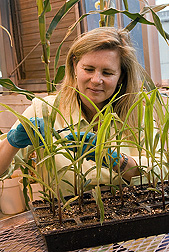This page has been archived and is being provided for reference purposes only. The page is no longer being updated, and therefore, links on the page may be invalid.
|
|
|
|
USDA Scientists, Colleagues Sequence Corn Genome
By Dennis O'BrienNovember 19, 2009
WASHINGTON, November 19, 2009—U.S. Department of Agriculture (USDA) scientists and their colleagues have completed a four-year effort to sequence the genome of corn, an achievement expected to speed up development of corn varieties that will help feed the world and meet growing demands for using this important grain crop as a biofuel and animal feed. The results represent the largest and most complex plant genome sequenced to date, and are the cover story in the November 20 issue of the journal Science.
"Sequencing the corn genome will help researchers in the United States and around the world develop corn varieties to confront critical global challenges like climate change, hunger, and renewable energy," said Edward B. Knipling, administrator of USDA's Agricultural Research Service (ARS), USDA's principal intramural scientific research agency. "This effort will provide scientists a preliminary blueprint for identifying genetic pathways that will lead to a better understanding of corn and enable scientists to improve corn in a number of ways."
The sequencing will help researchers uncover the relationships between corn genes and traits, develop an overall picture of the plant's genetic makeup, and broaden understanding of how the complex interplay of genetics and environment determines the plant's health and viability. The work also is expected to lead to development of corn varieties with higher yields and better tolerance of droughts, pests and diseases. It also should help scientists produce varieties with fibers, stalks and cellular structures that will make corn a better source of biofuel.
The team, which included Doreen Ware, a computational biologist at the ARS Robert W. Holley Center for Agriculture and Health in Ithaca, N.Y., has released the most comprehensive draft sequence to date, providing the most detailed look thus far at the functional portions of the corn genome. Ware led the computational effort and is a lead author of the report along with Richard Wilson of Washington University School of Medicine in St. Louis, Mo., and Patrick S. Schnable of Iowa State University at Ames. Other key participants in the project included the University of Arizona at Tucson and Cold Spring Harbor Laboratory in New York. USDA's National Institute of Food and Agriculture, along with the National Science Foundation and the U.S. Department of Energy, jointly funded the $29.5 million effort.
Edward Buckler, an ARS geneticist at the Holley Center, and Ware also have used next generation sequencing data to assemble a haplotype genetic map of the corn genome that lays out portions of the genome shared by 27 diverse inbred lines of corn. A haplotype is a combination of alleles—alternative forms of genes—that are located closely together on the same chromosome and tend to be inherited together. The corn lines in the haplotype genetic map were selected specifically because they represent the vast majority of the genetic diversity in corn. By searching through these lines, researchers and breeders can unlock corn's genetic potential and significantly accelerate the breeding of plants to meet the demands of the growing world population and the challenges of global climate change. Buckler's "HapMap," which also is published in Science, shows a 30-fold variation in recombination rates, which are the rates that genetic material from parents mix to show up in the progeny. The map is designed to function like the human genome HapMap, making it easier to link genes and genetic patterns with significant traits, Buckler said. The researchers already are linking the HapMap to the basis of hybrid vigor.
Corn, known among scientists as maize, is one of world's most important crops. Corn was a $47 billion crop in the United States last year. It is the largest production crop worldwide, providing not only food for billions of people and livestock, but also critical feedstock for production of biofuels. Ware said the work should serve as a foundation for understanding and improving on other agricultural crops as well. Plants previously sequenced include rice, sorghum, poplar, grape and Arabidopsis thaliana, a plant widely studied as a model organism.

